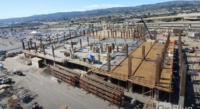Transportation infrastructure will need technology to help meet the needs of a growing urban population, and political will to fuel major projects and investor confidence. In the U.S., where a proposed bipartisan $2-trillion federal bill for infrastructure has met with skepticism, public-private partnerships are an ongoing potential tool despite a lack of overarching national guidelines.
Tim McManus, vice president of global projects for McKinsey & Co., noted that the global population will grow from over 7 billion to almost 10 billion in the next 30 years. Moreover, the population of those 65 years and older will grow from 600 million to 1.3 billion ,and the middle class will grow by 2.4 billion over the next 20 years. “Every year, 60 million people move into cities,” he said. “This will transform infrastructure development as we know it. It won’t be the same old, same old in technology and investments.”
He spoke at the RICS World Built Environment Forum, held in New York City May 13-14.
Traditional infrastructure is no longer only about moving people and goods, but data, said Brian Burkhard, global technology leader for Jacobs. He noted examples like Integrated Roadways, which offers a product of fiber-embedded concrete blocks that can charge electric vehicles and conduct short-range communications.
Moreover. “digitization affects everything we do,” he added. “It transcends all disruptions.”
But investors and builders have to be careful when considering technology trends, added Murray Rowden, global head of infrastructure for Turner & Townsend. “Digital infrastructure can go obsolescent faster than physical infrastructure.”
Aside from technology, governments must build up public confidence in major projects, noted Rowden, citing the example of the planned new Mexico City airport, which voters quashed in a referendum held by the new government. “The investment challenge is how to create funding models that are attractive.”
McManus added another example of how politics can stymie critical projects—the Gateway Project, which would replace the rail tunnels under the Hudson River between New York and New Jersey that were devastated by Superstorm Sandy. He cited a Regional Plan Association report that said a tunnel shutdown would mean a $30-billion economic impact.
“Out of 50 states, 34 allow public-private partnerships,” he noted. “And the legislation doesn’t match up. There’s no common strategy.”
A rise in global populism also poses a challenge to major project investments, said Rowden. Thus governments and project stakeholders much convince the populace of the importance of these projects. “How do we create shared value? Social value?”
Governments can either be enablers or obstacles to policies that would encourage both project investment and related technology. “Eighty percent of infrastructure is delivered by governments,” observed McManus. “They can be drivers of innovation by inclusion and risk-sharing.”




Post a comment to this article
Report Abusive Comment